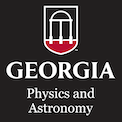Events Calendar View
-
Departmental Colloquium
Aug 20, 2015
The Broken Geometry of Life

Guest: Prof. Michael Bachmann, Department of Physics and Astronomy, The University of Georgia
Thursday, August 20, 2015 3:30 pm - 4:30 pm
Location: Physics Auditorium (202)Biomolecules such as proteins are finite and small (but not microscopic) systems that are of "in-between"sizes, i.e., they exist on mesoscopic length scales. This means, they are too large to allow for a quantum-chemical description of their physical properties and too small for a classical macroscopic approach. They do not even exhibit long-range symmetries, which would be helpful for their theoretical modeling. Nonetheless, processes that lead to functional structures of such molecules in a complex thermal environment surprisingly exhibit features known from thermodynamic phase transitions. Since the thermodynamic limit is out of sight, sophisticated computer simulations are currently the only way for the systematic study of the statistical mechanics of structural transitions in these systems. The striking finite-size effects that influence or even govern processes on mesoscopic scales lead to a couple of fundamental questions such as: What is temperature? In this talk, revised statistical mechanics concepts for finite systems, molecular models, and simulation methods are introduced. Examples of generic molecular structure formation processes such as protein folding, polymer aggregation, and macromolecular adsorption on solids will be discussed. -
CSP Lunch Seminar
Aug 25, 2015
The Galactic Star Formation Hierarchy
The birth of new generations of stars from the gas within galaxies is a basic process driving galactic evolution. A number of intriguing empirical “Kennicutt-Schmidt” relations have been found between the rate of star formation and the gas and dynamical properties of the host galaxy, but there is no consensus on the physical basis of these relations. Star formation in galaxies involves a vast range of scales from tens of thousands of light years of galactic disks down to about 1 light second scales of individual stars, and so is a hugely challenging computational problem. It also involves complex physical processes resulting from the interaction of self-gravitating gas, turbulence, magnetic fields, cosmic rays and radiation, along with astrochemical evolution of gas and dust in molecular clouds. I describe several numerical simulation projects that attempt to examine this Galactic Star Formation Hierarchy from the largest to the smallest scales, to try and elucidate the most important physical processes that are controlling star formation activity. -
Departmental Colloquium
Aug 27, 2015
Inside-Out Planet Formation
The Kepler-discovered systems with tightly-packed inner planets (STIPs), typically with several planets of Earth to super-Earth masses on well-aligned, sub-AU orbits may host the most common type of planets in the Galaxy. They pose a great challenge for planet formation theories, which fall into two broad classes: (1) formation further out followed by migration; (2) formation in situ from a disk of gas and planetesimals. I review the pros and cons of these classes, before focusing on a new theory of sequential in situ formation from the inside-out via creation of successive gravitationally unstable rings fed from a continuous stream of small (~cm-m size) "pebbles," drifting inward via gas drag. Pebbles first collect at the pressure trap associated with the transition from a magnetorotational instability (MRI)-inactive ("dead zone") region to an inner MRI-active zone. A pebble ring builds up until it either becomes gravitationally unstable to form an Earth to super-Earth-mass planet directly or induces gradual planet formation via core accretion. The planet continues to accrete until it becomes massive enough to isolate itself from the accretion flow via gap opening. The process repeats with a new pebble ring gathering at the new pressure maximum associated with the retreating dead-zone boundary. I discuss the theory’s predictions for planetary masses, relative mass scalings with orbital radius, and minimum orbital separations, and their comparison with observed systems. Finally I speculate about potential causes of diversity of planetary system architectures, i.e. STIPs versus Solar System analogs. -
CSP Lunch Seminar
Sep 1, 2015
Quantum simulation and quantum computing
-
CSP Lunch Seminar
Sep 15, 2015
Introduction to HPC using the New Cluster at GACRC
-
Departmental Colloquium
Sep 17, 2015
Changing Undergraduate STEM Instruction: Supporting the Learning and Instruction of Faculty
There is general acceptance among administrators and faculty that undergraduate STEM instruction needs to change. However, this is much easier for faculty and administrators to discuss than implement in universities that have a research mission. In this talk, I will share how STEM faculty at the University of Arizona became involved in a project that focused on improving undergraduate STEM instruction. Specifically, through different project initiatives there is support for the transformation of STEM faculty instruction and of department cultures to sustain the use of evidence-based, active learning instruction.
Page 60 of 121, showing 6 records out of 723 total, starting on record 355, ending on 360

